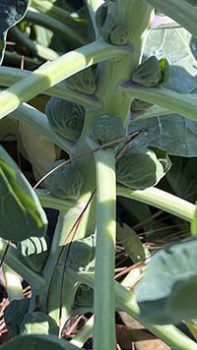
Brussels sprouts will hold up well through winter.
Last year’s deep-freeze caught most of us off guard. When the temperatures dropped below freezing, many of us were enjoying our holidays, rather oblivious to what turned out to be a 4-day stretch from December 21-26.
Caused by a historic extratropical cyclone that plunged much of the nation into a deep freeze with blizzards, high winds and snow, this weather system seriously affected North Georgia. Dubbed by the media as a once-in-a-generation winter event, the freeze wreaked much damage to plants and landscapes.
For those who elected to wait out the damage, resisting the urge to radically prune – or worse yet, remove – damaged plants, the rewards were obvious by early summer. Some freeze damage killed limbs of shrubs, such as tea olives, and negatively affected flowering plants, such as mophead hydrangeas, which didn’t bloom much in late summer if at all. However, by mid-summer, most of the shrubs had recovered.
In November and December, several snap freezes and heavy frosts have browned up our warm-season lawns and nipped tender plants that would have dropped their leaves anyway. Cool-season vegetables, such as Brussels sprouts, cauliflower and broccoli will hold up well through the winter, giving good crops in late spring.
Winter chores and some cautions
Now’s the time to plant trees and shrubs because they’re dormant and their roots will have time to grow to help make the transition to spring and summer. Just remember to water any newly installed trees and shrubs deeply at least once a week.
You can also do selective pruning of dead limbs and branches on trees and non-blooming shrubs. When the leaves are off, it’s easier to see the structure of the plants to improve their shape and reduce their size if necessary. If they’re close to your home, remove any limbs that are within a foot or two of your house or roof. This will prevent easy access by rodents who are trying to come inside for the warmth.
Continue to add to and turn your compost, mixing in shredded paper and non-meat kitchen scraps. As they decompose, you may see steam rising from the piles; this is perfectly natural. It means that the materials are breaking down into good rich organic matter to be added to your garden plots and applied to shrubs in the spring.
Keep your bird feeders filled, and go ahead and clean out your bluebird houses.
DO NOT PRUNE spring-flowering shrubs, including forsythia/yellow bells, native and single-season blooming azaleas, weigelia, mophead hydrangeas, oak leaf hydrangeas and viburnum. If you prune in the fall and winter, you greatly reduce the number of blossoms.
DO NOT PRUNE crape myrtles.
DO NOT CLEAN UP your perennial beds, even though they look messy. They provide seeds and shelter for birds and small wildlife.
If predictions are to be believed …
The Old Farmer’s Almanac’s forecast for winter 2024 in the South is “warmer and wetter than normal.” It has predicted that late January to mid-February provide the best chances for snow.
The National Oceanic and Atmospheric Administration also predicts a milder and wetter winter for the first couple of months of 2024.
A word to the wise …
You know what they say about meteorologists? They’re the only people who can do their job, be wrong at least 50 percent of the time and still get paid.
So the best advice is to be prepared to cover tender plants and respond to the short-term weather forecasts this winter. Let’s all hope for an early spring so that we can start our vegetable gardening early.




